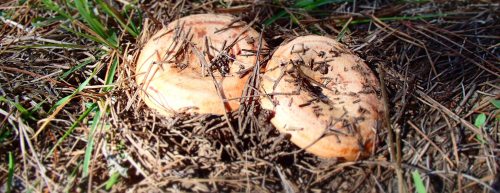
The slippery jack, Suillus luteus

Wingello State Forest, the ‘Please be careful’ sign not as ominous as at Belanglo
[Update: Check out new info page HERE and recent video HERE]
Having picked up mushrooming fever this autumn I have ventured out to broaden my horizons, considering slippery jacks (Suillus luteus) as the most likely candidate as they get the most mentions online (example). Heading down to visit a mate in Wingello for lunch and some fishing, I stop at Belanglo on the way for some saffron milk caps (Lactarius deliciosus) and in the afternoon we head out for the nearby Wingello State Forest. If I were I hunting the poisonous fly agaric (Amanita muscaria), Wingello would appear to be the place to go.

The fly agaric, Amanita muscaria
… and if I knew what these were and knew they were edible, they would have offered a huge haul. Maybe it is an edible oyster mushroom (Pleurotus spp.) but it remains more likely that it is a ghost mushroom (Omphalotus nidiformis), in which case it would make me sick, so pending any expert guidance out there just one new mushroom safely at a time for me I think.

Delicious or deadly?
Saffron milk caps were not as abundant as in previous outings in other forests, but the positive side was that the slippery jacks did indeed come through. In retrospect, the trees I was searching under were probably too young for milk caps as I have since read that trees over 10 years old are best, but I had to learn that at some stage and now I have. For the developing novice, slipperies seem to be the best next step after milk caps, being reputedly common and similarly easy to identify. For one thing, they are really are slippery, positively slimy in fact (at least in the current wet); and the undersides have a very characteristic pored structure.

More slimy than just slippery

The pored underside of a slippery jack
At the first stop we gather a few and head deeper into the forest for more. Passing some grey nomads camped in a clearing, we stop to ask if they are mushrooming in hope of pointers to a good spot. They weren’t, but were interested in seeing what we were after and I show them the slipperies and some of the milk caps from Belanglo, before heading off. Driving back past them 20 minutes later with nothing more for our efforts, they flag us down to ask if what they had gathered around their camp were the right ones. And they were – a good haul of both types. I tell them with complete confidence that the milk caps are fine to eat, but that having not yet tried the slipperies I wasn’t prepared to vouch for them with certainty. So they gave theirs to me. I reckon now that the camping areas in the State Forests – nothing more than grassy clearings with a toilet – might generally make good targets as they seem often to be ringed by some very old stands that are probably left alone longer by the loggers. We suddenly have a respectable enough load to call it a day, with a 2 year old boy in the back seat already being called on for an unfairly long spell in the booster seat.

Peeling a slippery jack seems easier than some say
Home, with the internet at hand, I peel, slice and fry one and am not enormously impressed. With butter, garlic and parsley it could no doubt be fantastic, as they turn out be quite absorbent little sponges of things, but that says more about those additions than it does for slippery jacks. The peeling is something that some seem to recommend because the skins are said to be a purgative, while others seem not to bother and feel it is too much effort. I found it very easy with a paring knife so I peeled the lot. Apart from the taste tester, I then sliced them for drying. Lacking (but coveting) a dehydrater, I did it in the oven.

Slippery jacks drying…

… and slippery jacks dried
Being related to boletes, of which Boletus edulis (cep or porcini mushroom) does so well dried, drying for later use in soup or at least rehydrating in stock seems the best way to go, particularly with the more palatable saffron milk caps likely to be on offer for fresh mushrooms whenever you might be getting slipperies.

Slippery jack, suillus luteus
Read Full Post »



























